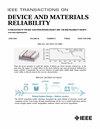功率循环-振动组合条件下IGBT模块寿命预测方法
IF 2.3
3区 工程技术
Q2 ENGINEERING, ELECTRICAL & ELECTRONIC
IEEE Transactions on Device and Materials Reliability
Pub Date : 2025-07-25
DOI:10.1109/TDMR.2025.3592624
引用次数: 0
摘要
某些绝缘栅双极晶体管(IGBT)模块,如汽车级IGBT模块,经常受到恶劣的使用环境。通常,温度变化和振动两个因素同时存在。在热应力和动态机械应力的共同作用下,Al焊丝裂纹扩展过程加速,导致IGBT模块过早失效。然而,对于功率循环-振动复合加载条件下IGBT模块的寿命预测方法,目前还知之甚少。首先,建立了一种适用于功率循环条件下IGBT模块寿命预测的寿命预测方法;该方法包括功率损耗模型、RC热网模型和集电极-发射极导通电阻(r_{\ mathm {ce}})退化模型。然后,通过有限元分析,将振动应力与热应力等效,在寿命预测方法中考虑振动对IGBT模块寿命的影响。该方法考虑了功率循环-振动复合工况下的使用条件和铝键线损伤累积对IGBT模块寿命的自加速效应。通过与实验结果的比较,验证了该寿命预测方法能够准确有效地预测功率循环工况和功率循环-振动复合工况下IGBT模块的寿命。本文章由计算机程序翻译,如有差异,请以英文原文为准。
Lifetime Prediction Method for IGBT Modules Under Combined Power Cycling–Vibration Conditions
Certain insulated gate bipolar transistor (IGBT) modules, such as automotive-grade IGBT modules, are often subjected to harsh service environments. Generally, two factors, temperature variation and vibration, exist simultaneously. Under the combined effects of thermal stress and dynamic mechanical stress, the process of crack extension in Al bonding wires accelerates, leading to the premature failure of IGBT modules. However, little is known about the lifetime prediction method that can be used for IGBT modules under combined power cycling–vibration loading conditions. First, this paper establishes a lifetime prediction method that is applicable for predicting the lifetime of IGBT modules under power cycling conditions; this method includes a power loss model, an RC thermal network model and a collector–emitter on-resistance $(r_{\mathrm { ce}})$ degradation model. Then, the effect of vibration on the lifetime of the IGBT module is considered in the lifetime prediction method by equating the vibration stress with the thermal stress via finite element (FE) analysis. The method considers the service conditions under combined power cycling–vibration conditions and the self-acceleration effect of Al bond wire damage accumulation on the lifetime of IGBT modules. Using comparisons with experimental results, it is verified that the lifetime prediction method can accurately and efficiently predict the life of an IGBT module under both power cycling conditions and combined power cycling–vibration conditions.
求助全文
通过发布文献求助,成功后即可免费获取论文全文。
去求助
来源期刊

IEEE Transactions on Device and Materials Reliability
工程技术-工程:电子与电气
CiteScore
4.80
自引率
5.00%
发文量
71
审稿时长
6-12 weeks
期刊介绍:
The scope of the publication includes, but is not limited to Reliability of: Devices, Materials, Processes, Interfaces, Integrated Microsystems (including MEMS & Sensors), Transistors, Technology (CMOS, BiCMOS, etc.), Integrated Circuits (IC, SSI, MSI, LSI, ULSI, ELSI, etc.), Thin Film Transistor Applications. The measurement and understanding of the reliability of such entities at each phase, from the concept stage through research and development and into manufacturing scale-up, provides the overall database on the reliability of the devices, materials, processes, package and other necessities for the successful introduction of a product to market. This reliability database is the foundation for a quality product, which meets customer expectation. A product so developed has high reliability. High quality will be achieved because product weaknesses will have been found (root cause analysis) and designed out of the final product. This process of ever increasing reliability and quality will result in a superior product. In the end, reliability and quality are not one thing; but in a sense everything, which can be or has to be done to guarantee that the product successfully performs in the field under customer conditions. Our goal is to capture these advances. An additional objective is to focus cross fertilized communication in the state of the art of reliability of electronic materials and devices and provide fundamental understanding of basic phenomena that affect reliability. In addition, the publication is a forum for interdisciplinary studies on reliability. An overall goal is to provide leading edge/state of the art information, which is critically relevant to the creation of reliable products.
 求助内容:
求助内容: 应助结果提醒方式:
应助结果提醒方式:


